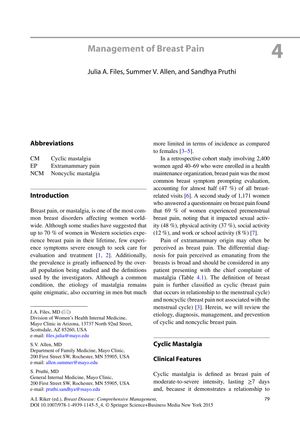Management of Breast Pain
September 2014
in “
Springer eBooks
”

TLDR The document concludes that breast pain should be managed with personalized treatment, starting with non-drug methods and progressing to medication if necessary, while considering side effects and patient needs.
The document from 2014 addresses the management of breast pain, affecting up to 70% of women, with a focus on individualized treatment based on age, clinical findings, and quality of life impact. Diagnostic approaches vary, with targeted ultrasound for those under 30 and additional mammography for those over 30, or when a mass is palpable. Imaging has a low yield for cancer detection. Initial treatments include non-pharmacologic methods like proper bra fit and relaxation, with mixed results from dietary changes and supplements. Pharmacologic options are considered when these fail, including hormone therapy adjustments, oral contraceptives, and FDA-approved medications like danazol, with potential side effects. Dopamine agonists, SERMs like tamoxifen, and gonadotropin-releasing hormone agonists are effective but have significant side effects. Simple analgesics are first-line for mild-to-moderate pain, and hormone agonists are used short term. Surgical management is not recommended. Treatment choice should consider patient expectations, side effects, and symptom severity, with ongoing follow-up due to the variable nature of symptoms and potential for resolution. Further research is needed to evaluate new treatments.